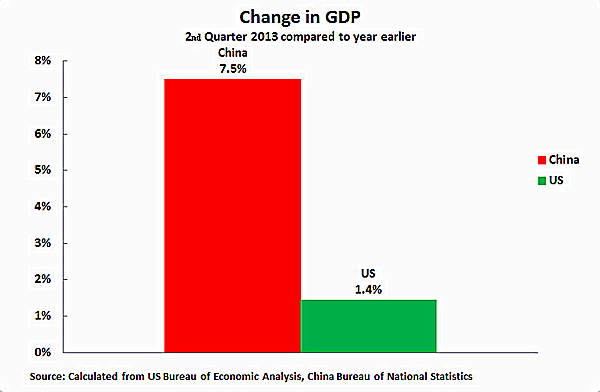Time to slow down talk of slowdown
- By John Ross
 0 Comment(s)
0 Comment(s) Print
Print E-mail China.org.cn, August 6, 2013
E-mail China.org.cn, August 6, 2013
The recent publication of America's 2nd quarter GDP data, following that for China, makes it possible to accurately compare the recent performance of the world's two largest economies and the results are extremely striking. In the last year the slowdown in the U.S. economy has been far more serious than in China. Therefore while both economies are being adversely affected by current negative trends in the world economy, China is dealing with these much more successfully than the U.S. In light of media discussion about China's economic "slowdown" it is equally important that attention is paid to understanding why the U.S.'s own economic slowdown is much worse than China's when confronted with similar global economic trends.
First, to accurately establish the facts, it should be noted China and the U.S. publish their economic data in slightly different forms and it is therefore necessary to ensure that we compare like with like. The U.S. emphasizes annualized change in GDP in the latest quarter compared to the previous one; for the newest data this means it takes the growth between the 1st and 2nd quarters of 2013 and basically multiplies it by four. China emphasizes the growth between the 2nd quarter of 2013 and the same quarter in 2012.
Both methods have advantages and disadvantages. Quarter by quarter comparisons depend on seasonal adjustments being accurate, which is not always the case, while year by year comparisons are less sensitive in registering short term shifts.
But in the present case the conclusion is not fundamentally changed, whichever method is used. If the method emphasized by China is used, then, as shown in Figure 1, in the 2nd quarter of 2013 China's GDP grew by 7.5 percent compared to a year earlier, while U.S. GDP grew by 1.4 percent. This means that China's economy grew at over 500 percent of the rate of the U.S. economy. Using the method preferred by the U.S. China's annualized GDP growth in the 2nd quarter was 6.8 percent and the U.S.'s was 1.7 percent, which means that China's economy grew at 400 percent of the rate of the U.S. economy.
Due to the difficulties of making accurate seasonable adjustments in both China and the U.S., I would emphasize the year on year comparison; but whichever method is preferred China's economy was growing at 4-5 times the speed of the U.S. economy.

If we take the whole period since the international financial crisis began then the disparity in growth between China and the U.S. is even more striking. In the five years up to the 2nd quarter of 2013 China's GDP grew by 50.7 percent and U.S. GDP by 4.5 percent (Figure 2). China's GDP grew more than ten times as rapidly as the U.S.

Turning to the most recent period, it is clear that since the beginning of the international financial crisis, China's economy has far outperformed the U.S., even if the dimensions of this are not clearly grasped. What is not so often understood is what has happened during the last year. During that period the economies of both China and the U.S. slowed, indicating the negative trends in the international economic situation. But the U.S. slowed far more than China.
China's year on year GDP growth fell from 7.6 percent in the 2nd quarter of 2012 to 7.5 percent in the same quarter of 2013 - a decline of 0.1 percent - or a 1.3 percent deceleration from the initial growth rate. However the year on year growth rate of the U.S. in the same period fell from 2.8 percent to 1.4 percent - that is by 1.4 percent or by 50 percent of the initial growth rate. Consequently China's growth fell marginally but the U.S.'s growth rate halved.
Furthermore, as the Financial Times correctly pointed out in its editorial on the latest U.S. data, U.S. economic growth has been particularly depressed in the last nine months. In that total period the U.S. economy grew by only 0.7 percent, or an annualized rate of under 1 percent. In the same period China's economy grew by 5.3 percent, or an annualized rate of slightly over 7 percent. Therefore if over the entire course of last year China's economy has been growing at 4-5 times the speed of the U.S. economy, in the last nine months China's economy has been growing at 7 times the speed of the U.S.
None of this, of course, means that China does not have to take serious measures to avoid further economic slowdown. I have argued for most of the year that a moderate domestic stimulus package was required and was therefore pleased to see the steps taken in that direction in July by China's economic policy makers with help to exporters, the temporary lifting of VAT on small businesses and accelerated railway construction. But the attempt made in some sections of the media to present a picture that China's economy in the last year has been experiencing "slowdown" while the U.S. has been "recovering" is contrary to the facts. In the last year both economies have slowed under the impact of deteriorating global trends, but China's slowdown has been marginal while the U.S. economy has slowed substantially.
The latest data therefore shows that the relevant global economic discussion about the present world economic situation is not about China's "slowdown" and U.S. "recovery," because that is not what is happening. Instead it is "why is China coming so much more successfully through an adverse global economic situation than the U.S.?" And "why has the U.S. economy slowed so much more dramatically than China's in the last year?"
The author is a columnist with China.org.cn. For more information please visit:
http://www.china.org.cn/opinion/johnross.htm
Opinion articles reflect the views of their authors, not necessarily those of China.org.cn






Go to Forum >>0 Comment(s)